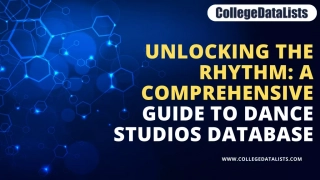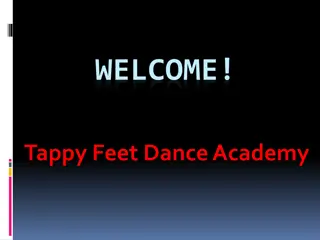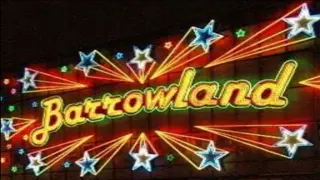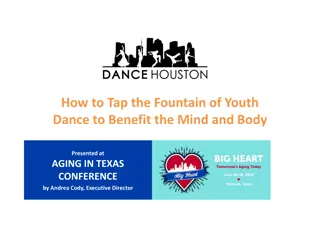Interpretation and Analysis of "Passchendaele" Dance Performance
Explore the choreographic intention and theme of the dance performance "Passchendaele" by Neil Ieremia, presented by The Royal New Zealand Ballet. The performance delves into the emotional impact of war, focusing on honoring sacrifices and reuniting loved ones through a metaphysical journey. Supported by expressive movements and a solemn backdrop, the dance conveys the brutality and loss experienced in war, leaving a lasting impression on viewers.
Download Presentation

Please find below an Image/Link to download the presentation.
The content on the website is provided AS IS for your information and personal use only. It may not be sold, licensed, or shared on other websites without obtaining consent from the author.If you encounter any issues during the download, it is possible that the publisher has removed the file from their server.
You are allowed to download the files provided on this website for personal or commercial use, subject to the condition that they are used lawfully. All files are the property of their respective owners.
The content on the website is provided AS IS for your information and personal use only. It may not be sold, licensed, or shared on other websites without obtaining consent from the author.
E N D
Presentation Transcript
AS91211 PROVIDE AN INTERPRETATION OF A DANCE PERFORMANCE WITH SUPPORTING EVIDENCE & AS91594 ANALYSE A DANCE PERFORMANCE EXAM EXTERNAL = 4 CREDITS
PASSCHENDAELE Choreographer Neil Ieremia Performed by The Royal New Zealand Ballet
LINKS TO WEBSITES ABOUT WWI https://www.youtube.com/watch?v=IiVUIJ282uI - Turning Points of History Passchendaele https://www.youtube.com/watch?v=cc7ehb8agWY - Shell Shock https://www.youtube.com/watch?v=GalJQY3PaQk - In Flanders Fields https://www.youtube.com/watch?v=d7MuMnss4Rw - Dulce et Decorum Est http://www.teara.govt.nz/en/video/46404/great-war-stories-leonard-hart - Leonard Hart - Personal Letter from Passchendaele
CHOREOGRAPHIC INTENTION AND THEME OF THE WORK Neil Ieremia s focus has been on exploring a perspective that honours and respects the sacrifice made by so many at Passchendaele, whilst registering the courage of those who were left behind to reassemble the broken pieces of a young nation. The dance is set in a metaphysical place shared through memories, dreams and visions, a place where time and space are in suspension. It brings together those who have been separated by war husbands and wives, mothers and sons, brothers and sisters, and provides an imagined opportunity to be together one last time.
The movement palette is simple yet expressive of the emotional impact of unimaginable loss. The backdrop evokes a sense of solemnity and the desolation of humanity in war. Neil Ieremia wanted to bring life to the scenario, rather than take it. The grotesque and brutal nature of war robs humans of humanity Ieremia s intention is to do what little he can to remind us of our own.
From the haunting journey through the music, to the refined expression in the dancers bodies, encapsulating the very human impact of war the creative process has already left an indelible mark on my spirit. I feel I have grasped a very, very small insight into something that should never be forgotten. - Neil Ieremia
COMMUNICATION OF IDEAS IN PASSCHENDAELE Write a detailed description of the Choreographic Intention what main theme does Neil Ieremia want to show and how does he show this? Use examples to justify this. Write detailed descriptions on ideas expressed in each section of the dance extract. (What happens in each section? What idea does each section show and how is it shown? Think about movement, costuming, groupings, gender role, relationships etc.) Include examples that justify your explanation.
PURPOSE OF PASSCHENDAELE What do you consider to be the purpose of the dance performance of Passchendaele? Write a detailed answer, with examples, to this question considering the following: How does Neil Ieremia show the purpose what examples illustrate this? Why do you think he uses certain choreographic decisions in Passchendaele as a means to communicate his message? (Give specific examples) How might an audience respond to Passchendaele? (How effective is it? Can you relate it to a wider context?)
WRITE A LETTER FROM THE TRENCHES Imagine you are at the Western Front, in the Trenches, knowing that in a few hours the whistle will be blown to signal the moment you have to rise up and face the enemy gunfire as you charge. Write a letter to a loved one e.g. describing your thoughts, feelings, surroundings, sights, and / or smells. Think of how you want your loved ones to remember you (these may or may not be the last words you ever get to say to them). When you have finished writing your letter, swap with another person and you will each reply to that letter as if you are the person who has received it (the loved one back home). Be prepared to share some of these with the class.
KEY IDEAS IN PASSCHENDAELE The following activity is to help you reflect upon the Key Ideas shown in the dance Passchendaele. You will work in groups of 3-4 and complete the following table (on a sheet of A3). You may also come up with additional Key Idea(s). Each group will then present their information to the class. I will take a photo of these and add them to the Freybergdance Blog.
IMPORTANT IDEAS SEEN IN THE DANCE Key Ideas expressed throughout the dance Description of Movement Example and Dance Elements used/ Choreographic Devices used How does the movement described reflect the Key Idea? Naivety of the Nzers going to war (a big adventure) Women left at home their role Reality of War (on the Battlefield) Impact of War (mentally / physically) Other -
SYNTHESISING YOUR INFORMATION Select ONE of the Key Ideas from the table (and using all the information presented by the groups as a guide) write a paragraph (or two) that explains how the Key Idea is shown in Passchendaele and its effectiveness how it relates to the choreographic intention. You might also like to comment on the wider implications of the Key Idea e.g. How might it be relevant in today s society? What are the implications for humanity?
QUESTIONS TO PONDER In groups of 3-4 consider the following questions and make a few notes on these. Be prepared to discuss your ideas with the class. What do you think society has learned (if anything) from the history of battles such as Passchendaele? Did the choreography of Passchendaele do enough to make you think about the issues of war mental and physical impact? Why / Why not? Which sections / movements of Ieremia s choreography had the most impact on you and why? you can also consider other sections not included in the exam extract.
ACHIEVEMENT CRITERIA LEVEL 2 Achievement Achievement with Merit Achievement with Excellence Provide an interpretation of a dance performance with supporting evidence. Provide an in-depth interpretation of a dance performance with supporting evidence. Provide a perceptive interpretation of a dance performance with supporting evidence. LEVEL 3 Achievement Achievement with Merit Achievement with Excellence Analyse a dance performance. Analyse a dance performance in depth. Comprehensively analyse a dance performance.
ASSESSMENT REQUIREMENTS LEVEL 2 There will be THREE questions. In 2016, candidates must answer all three questions. Each question may contain more than one part. Questions will be assessed holistically. Candidates will be required to respond in in bullet-point form, paragraph form, diagrams, or sketches. Diagrams or sketches will be assessed on the quality of information conveyed and not their artistic merit (i.e. simple stick figures are satisfactory). Candidates should label their diagrams or sketches to indicate features that may not be clear. Questions may include bullet-pointed examples to provide guidance for candidates. These examples are not intended to limit candidates answers. Candidates must use ink for both sketched and written answers.
FORMAT OF THE ASSESSMENT LEVEL 2 Candidates will be required to answer three questions relating to a dance performance they have viewed and studied. Candidates will be given 5 minutes to read the questions. A video of the dance performance (3 6 minutes in duration) will then be shown, twice, with a pause of 10 minutes in between. Candidates may start making notes or answering the questions at any time after the examination begins.
CONTEXT OF ASSESSMENT LEVEL 2 Candidates will be required to answer questions on a number of key aspects of a dance performance they have studied. Candidates should be familiar with: movement aural design choreographic intention choreographic influence or stimulus Note: aural design could include music, sound(s), body percussion, voice, silence. Candidates may refer to key aspects not shown in the recording to support their answers.
FORMAT OF THE ASSESSMENT LEVEL 3 Candidates will answer one question relating to a dance performance they have viewed and studied. Candidates will be given 5 minutes to read the questions. A video of the dance performance (3 6 minutes in duration) will then be shown, twice, with a pause of 10 minutes in between. Candidates may start making notes or answering the questions at any time after the examination begins.
CONTEXT OF ASSESSMENT LEVEL 3 Candidates will be required to answer a question on key aspects of the dance performance. Candidates should be familiar with: the use of time the significance of the title the communication of meaning. Candidates may refer to key aspects not shown in the video to support their answers.























